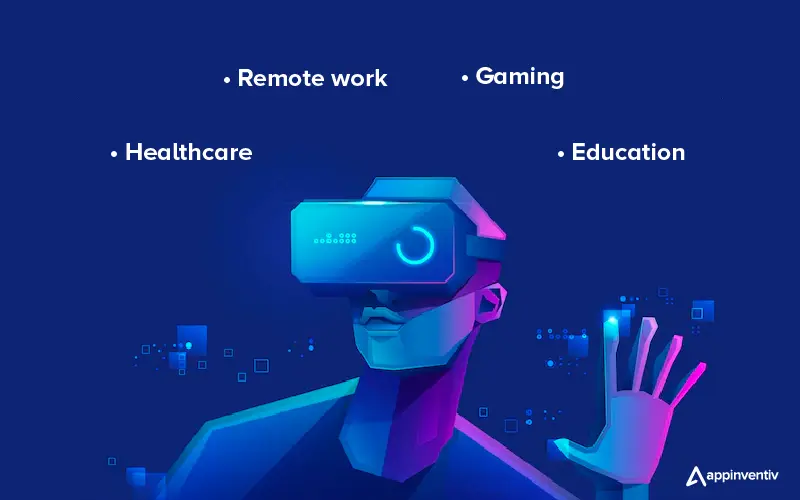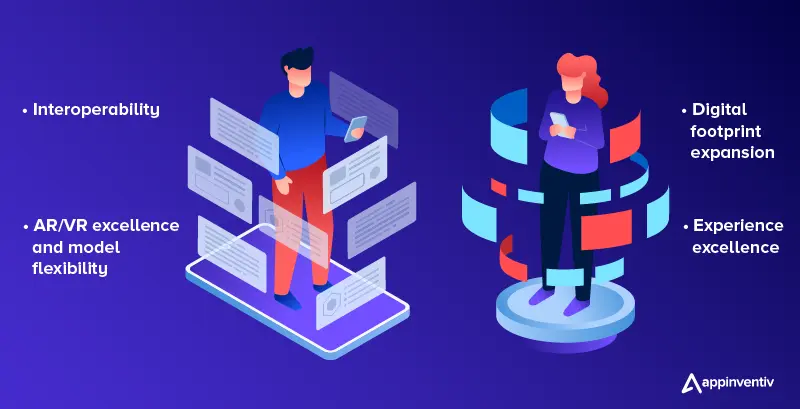- A look at the Metaverse-as-a-Service platform
- Use cases that demand MaaS solutions
- Remote work
- Healthcare
- Education
- Gaming
- Companies adopting the MaaS business model
- Lovelace World
- Propel MaaS
- Touchcast
- How to build a Metaverse-as-a-Service platform?
- Interoperability
- AR/VR excellence and model flexibility
- Digital footprint expansion
- Experience excellence
- FAQs
The Metaverse has generated a new avenue for enterprises to build and deploy services. And as businesses start showing their interest in this latest innovation, Metaverse-as-a-Service platforms have popped up, facilitating new revenue streams and a chance for enterprise excellence.
In this blog, we will deep-dive into what a Metaverse-as-a-Service platform is, how it can be built, and what use cases showcase its immense potential for businesses of all shapes and sizes.
Meanwhile, if you wish to know more about what metaverse is all about, head on to this blog – Metaverse: The New Web is Here, Where are You?
A look at the Metaverse-as-a-Service platform
To better understand user preferences and to test out different models and modes, companies are already leveraging existing Metaverses like Decentraland and Roblox. What is next is companies building their own 3D worlds that integrate into the Metaverse narrative and offer audiences a wide array of services and facilities—from shopping and doctor consultations to group yoga sessions and educational experiences.
Metaverse-as-a-service, or MaaS, can simply be described as an enterprise solution that will enable businesses to penetrate the Metaverse with their own virtual worlds for a variety of use cases that span from healthcare and finance to entertainment, learning, and more.
Now, this does not mean MaaS will be used as a tool for competing with Decentraland and Roblox. On the contrary, it will be a model that will help enterprises penetrate the existing Metaverse infrastructure and build on it to integrate their businesses into it, similar to how software-as-a-service, or SaaS, operates.
Now, in our next section, let’s have a look at what’s exactly creating the demand for MaaS services.
Use cases that demand MaaS solutions

While the use of the Metaverse can be done for virtually anything (pun intended), when it comes to business, some specific use cases are gaining momentum, making a big room for MaaS platform solutions. Let’s briefly discuss some such use cases below.
Remote work
While remote work is here to stay, people still miss in-person meetings, brainstorming sessions, and team-building activities. The Metaverse bridges this gap, using a virtual office environment you can work in, accelerating collaboration and improving the impact of different initiatives that concern your team.
Microsoft launching its Metaverse software for integration with the company’s video conferencing app, Teams, is a leap forward in the concept. With even leaders like Facebook (new Meta) working to develop Metaverse platforms for work, it is needless to say that the demand for offices in the Metaverse will be huge in the near future, thus fostering the demand for MaaS solutions.
Healthcare
From using the Metaverse to share sensitive patient data securely to boosting collaboration between departments, the Metaverse offers limitless possibilities for the domain. Some of the key benefits lie in using AR for robotic surgeries, cognitive therapy, using virtual support groups for patients, carrying out psychiatric assessments, facilitating quicker rehabilitation through virtual collaboration, and using haptic sensors for physical therapy. The industry has barely scratched the surface of the Metaverse—and a tsunami of demand is around the corner.
Education
Extending virtual learning hubs and taking the concept of campus online, the Metaverse offers a great opportunity for learning and education. One of the biggest advantages of the Metaverse is its ability to facilitate long-distance collaboration between students and teachers and engaging learning models that use games/scenarios.
Education Metaverse startups are exploding as we speak, with companies like ClassVR and Stemuli blazing the trail with innovative learning models and setups. And the demand is set to skyrocket. Attempts are being made by market leaders to develop Metaverse platforms for this use case—and so far, there is no monopoly in the market.
Gaming
The immersive Metaverse gaming environment provides a unique experience to gamers, while also providing businesses with new marketing opportunities. The next big wave of play-to-earn gaming models will be dominated by the Metaverse.
Some of the popular metaverse platforms in the domain include Axie Infinity, Sandbox, Illuvium, Chain of Alliance, Alien Worlds, and more. Considering the demand for gaming and the current supply in the realm of the Metaverse, the scales are as uneven as they can be. The demand far outpaces the supply. If you develop a Metaverse platform for this use case, the sky’s the limit.
And that’s not all. The applications of the Metaverse can be lucrative for businesses in the domains of social media, travel, finance, real estate, customer-facing ventures, and much more.
With such a large number of metaverse use cases, it is evident that only a handful of metaverses would not be able to sustain the demand in the future. Therefore, metaverse-as-a-service will invariably become a dominant business model in the future as industries recognize the value of having dedicated spaces.
As a matter of fact, many organizations have already started providing MaaS services as part of their offering to their clients. Let’s look at some such metaverse-as-a-service examples in the next section.
[Also Read: How to Develop a Metaverse Platform for your Sportswear Brand?]
Companies adopting the MaaS business model
Here are some companies that have adopted MaaS as a crucial aspect of their enterprise offering—and are trailblazing the domain.
Lovelace World
Lovelace World’s expertise lies in providing end-to-end MaaS solutions that are designed to streamline Metaverse adoption for its clients.
The company’s MaaS toolkit helps its clients monetize VR games, seamlessly integrate with other platforms, develop/indulge in NFT experiences, and even operate smart contracts across Cardano—and several other chains.
Propel MaaS
This company, while in its infancy, is quickly becoming known for the efficiency of its plug-and-play Metaverse solutions and services.
The company specializes in building and deploying smart contracts for verification, negotiation, resolution, and measuring the overall performance of Metaverse environments. It also provides gaming, Defi, and NFT integration services to its clients.
Touchcast
This company is gaining much-deserved hype across event companies and corporates. The company allows its clients to claim their own .metaverse domain and build their own Mcity (a unique offering of Touchcast) with agile services, scalability, and easy integrations.
Now, let’s talk about how you can build a MaaS platform effectively and position your business for success.
How to build a Metaverse-as-a-Service platform?

Contrary to popular belief, your business can enter into the Metaverse in a few easy steps with the help of our experts. Here are some key considerations that will help you build the ideal MaaS platform—and put it to work!
Interoperability
Finding the right platform is one thing. What you would have to strive for while building your Metaverse-as-a-Service offering is interoperability between major platforms like iOS, Xbox, and Android, across multiple identities, and among different payment methods, just like Fortnite.
This is the first consideration for laying the framework for MaaS.
AR/VR excellence and model flexibility
Now, comes the development of your asset. AR/VR technologies will be at the forefront of your asset development and whether it is a game or a virtual office space, your model needs to be innovative, adaptable, and scalable to meet the needs of your clients. Remember: They might buy a MaaS offering from you now. But if it doesn’t match the experience quality or scale along with their demands, they will switch to the competitors.
Now, let’s focus on a couple of aspects that will help you get one step ahead of your peers.
Digital footprint expansion
Boosting your online presence would become essential for your MaaS offering to work. You will need to tap into the audience interested in this niche and cater to them with a relevant website, and easy access to your VR services.
Experience excellence
Merging traditional brand experiences with new age experiences is a surefire way to not only charm your audience but it also creates new selling and revenue opportunities you can use as a USP while connecting to clients.
Needless to say, our Metaverse development services walk you through all of these steps and more, helping you make your MaaS platform a reality. The custom Metaverse development platform is designed to help you unlock the domain’s true potential for your enterprise, with minimal effort.
Now that you know all about deploying your own Metaverse-as-a-Service platform, you have an insight into what the future of business and commerce might look like. As a metaverse development company, we at Appinventiv offer end-to-end solutions to help businesses like yours catapult your service portfolio into the future with comprehensive Metaverse as a Service development tools and consistent technological support—so you can make your vision a reality and secure future leadership.
FAQs
Q. How much does it cost to build a Metaverse-as-a-Service platform?
A. It depends on the kind of solutions/services you want to target and what your ideal use cases are. We at Appinventiv work with your teams to custom-tailor our services as per your specific needs—so you can make the most of your budgets. Still, to know the exact cost estimation for your MaaS project, connect with our experts.
[Also Read: How much does it cost to develop the Metaverse?]
Q. How much time does it take to develop a Metaverse platform?
A. Depending on the technical expertise you have on board and the kind of tools you work with, developing a Metaverse platform can take you anywhere between a few weeks and several months. That’s where we come in, streamlining the process and fast-tracking your journey to the Metaverse with our solutions that are designed to get you up and running in the shortest possible time.
Q. What are the benefits of Metaverse-as-a-Service for enterprises?
A. Metaverse is a new domain most businesses are showing interest in and market leaders are opening new avenues in at the moment. It is a tidal wave that is coming to the world of remote working, gaming, enterprise collaboration, and even innovation as a whole. Deploying MaaS gives you the ability to help clients ride this wave and secure future leadership in their domains. Some of the top benefits include new revenue streams (from in-game purchases, crypto exposure, etc), streamlined work-from-anywhere, expansion of customer base, cross-platform and cross-enterprise collaboration/integration, and more. We at Appinventiv have been revered as one of the best metaverse development companies by our clients and we deliver customized solutions to ensure our clients are able to bag these benefits with minimum effort.


Excellence Together

Building Virtual Worlds: How Digital Twins Power the Enterprise Metaverse
The metaverse is changing the online world. Just like Web 3.0, it's a game changer for businesses. Central to this change is Digital Twins, a leading-edge technology that makes the virtual worlds of the metaverse possible. The metaverse will likely be the next considerable economic power when the internet blends with real life. Estimates show…

Metaverse in Training: Top 7 Use Cases and Benefits
The concept of the metaverse in training is revolutionizing how we approach learning and skill development. Experts predict a growth in the metaverse education market to an impressive $24.7 billion by 2030, showcasing a 43.76% CAGR during the 2023-2030 forecast period. This surge in interest is not surprising, given the unique benefits and applications of…








